Field Mappings Tab for Primavera P6 Source Plans in OnePager Version 7.1
Contents
Overview
Illustrations used in this article and referenced articles are from OnePager using Oracle Primavera P6 XML Formatted source plans but the feature's function, controls, and manual edits apply equally to One Pager when OnePager is used to create charts from Oracle Primavera P6 XER Formatted source plans. Where there are significant differences between the Field Mappings tabs for XML and XER Formatted source plans the differences are noted.
What Is Unlimited Field Mapping?
The Unlimited Field Mapping feature lets you use a source plan column that is not already available to you in the Chart Editor. The feature allows you to avoid going back to the Template Properties form to map additional columns for the specific purposes you need without having to recreate a new chart. Having to recreate a new chart is cumbersome and inefficient, especially if you already invested time editing the original chart before you realized that you needed another source plan column.
The Unlimited Field Mapping (UFM) feature is a vastly more efficient way to bring additional source plan columns into the Chart Editor after you've created and edited your chart. Previously, OnePager only had access to Oracle Primavera P6 source plan columns that were specifically mentioned in the OnePager Template Properties form. With UFM, the Chart Editor can access all source plan columns.
Field Mapping is defined as the use of a source plan column for a particular OnePager purpose. There are more than twenty-five (25) OnePager purposes from Baseline Finish Date to Unique task bar/milestone symbol identifier. You can easily refer back to your source plan and access changed columns from the Chart Editor.
For example, you can populate a Text column in Oracle Primavera P6 and then use that column to present data in an Text Column after the chart is first created. Further, OnePager gives you a more efficient way to change the field mapping for seven (7) of the most frequently used OnePager presentation purposes.
For OnePager for Oracle Primavera P6 there are eight (8) such purposes for XER Formatted source plans and seven (7) purposes for Oracle Primavera P6 XML Formatted source plans because it omits display of critical path information. These differences are discussed in the following sub-sections.
For more information on Field Mapping, please see the Frequently Asked Questions topics at: Field Mapping
The Field Mapping Tab
Since the Unlimited Field Mapping feature allows you to access all available columns from Oracle Primavera P6 source plans at any time in the life cycle of a chart, the Field Mappings tab no longer needs to map columns to extra purposes that are just carried along in case you need them.
The Field Mapping tab focuses on common OnePager purposes that users can map to Oracle Primavera P6 columns after a chart is created. Note, however, that other important OnePager purposes are on Rows/Swimlanes, Task Bars, and Milestones tabs. Some purposes such as Task Name, Percent-Complete, and Critical Path may appear both on the Field Mapping tab and on the Task Bars and Milestones tabs.
For Oracle Primavera P6 XML Formatted source plans there are seven (7) purposes named in the Field Mappings tab: (1) Percent-complete, (2) Task-name, (3) Start date, (4) Finish date, (5) Baseline start date, (6) Baseline finish date, (7) Deadline date.
For Oracle Primavera P6 XER Formatted source plans there are seven (8) purposes named in the Field Mappings tab: (1) Percent-complete, (2) Critical-path Segments, (4) Task-name, (5) Start date, (6) Finish date, (5) Baseline start date, (7) Baseline finish date, (8) Deadline date.
The Field Mappings tabs for the Chart Properties forms for Oracle Primavera P6 XML and XER Formatted source plans are shown below:
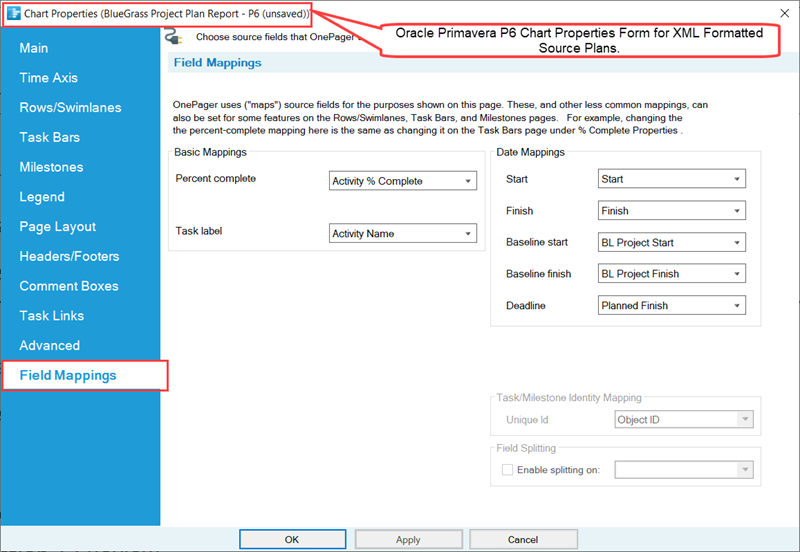
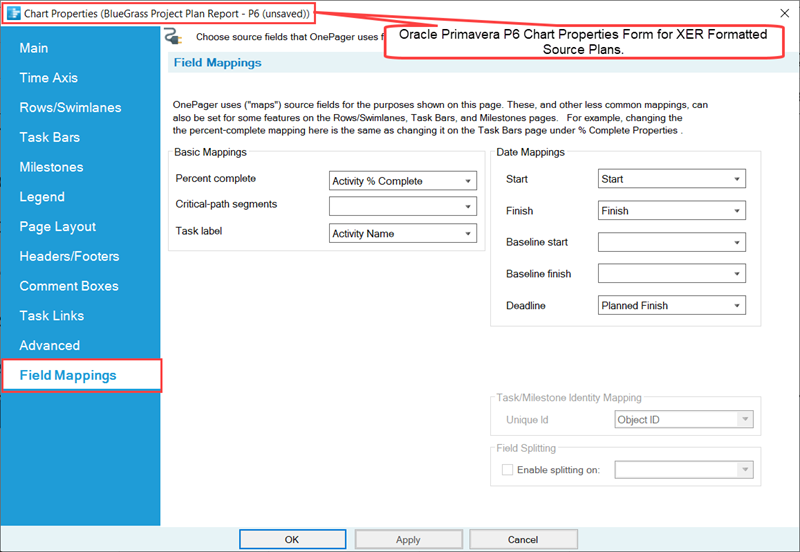
For more information on the Unlimited Column Mapping feature, please see the article at: Unlimited Field Mapping
Special Considerations for the Task/Milestone Identity Mapping Feature
The Field Mappings tab shows the Oracle Primavera P6 column currently being used for the Task/Milestone Identity Mapping feature. In the Chart Properties form, the Task/Milestone Identity Mapping is disabled but tells you which Oracle Primavera P6 column is being used. The Task/Milestone Identity Mapping column being used is specified in the Template Properties form to act as an alternate Unique ID column for OnePager UPDATE operations. You can change it to whatever column you want, but it is your responsibility to make sure that the chosen column has a unique value for each task you plan to import and display in OnePager. Having duplicate values in the Unique ID column causes task bars to be omitted and/or misidentified later on when you are doing updates of the chart.
For Oracle Primavera P6 XML and XER Formatted source plans the convention is to use the Object ID column for this purpose. For this reason Template Properties forms distributed with OnePager for Oracle Primavera P6 have the Unique Id control preset to Object ID.
Special Considerations for the Field Splitting Feature
OnePager supports Field Splitting with the control on the Field Mappings tab in the Template Properties form and Chart Properties forms. Field Splitting can be performed on any source plan string type columns with comma-separated components imported before the chart is created. It cannot be changed once a chart is created, though its value is shown in the Chart Properties form to remind you of the splitting that is active in the chart.
Field Mappings
There are four (4) controls groups found on the Field Mappings tab.
Basic Mappings
Within the Basic Mappings control group there are two (2) basic columns for XML Formatted source plans and three (3) basic columns for XER Formatted source plans already established that can be remapped. You can use any Oracle Primavera P6 column of the appropriate type corresponding to the Basic Mapping column named for the dropdown.
The dropdown list for the Task label column is shown in the examples below:
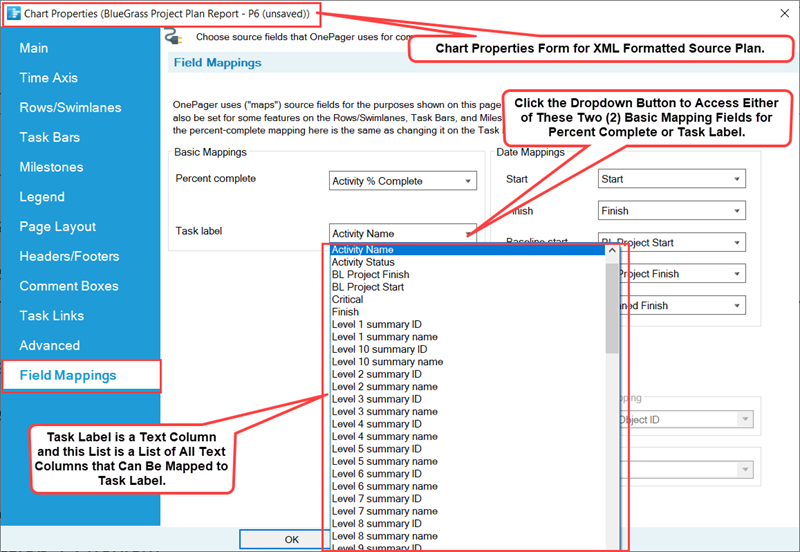
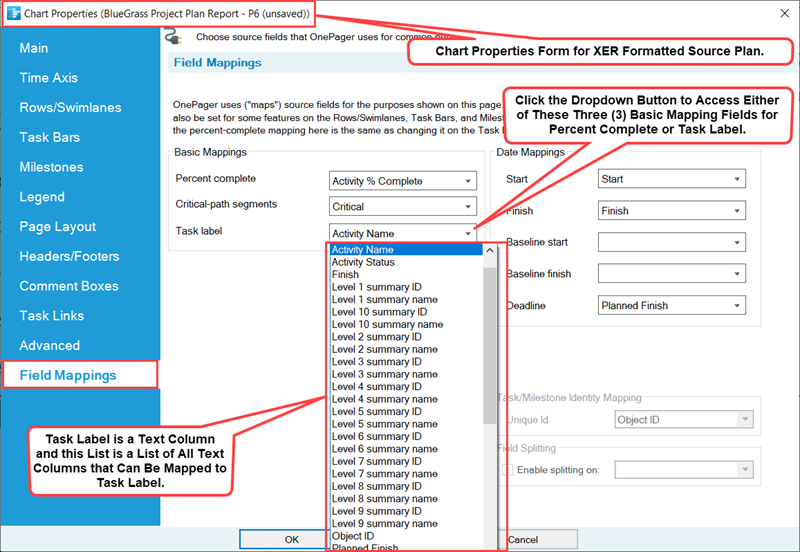
Selecting a different Oracle Primavera P6 columns from the dropdown list tells OnePager to go back to the Oracle Primavera P6 source plan, retrieve the data for that column, and use that data for the purpose of the chart. This re-acquisition of Oracle Primavera P6 source plan data is done when you click Apply on the Chart Properties form which keeps the Chart Properties form visible or when you click OK which closes the Chart Properties form. The current chart is updated accordingly in the Chart Editor. The process for the other Basic Mapping column for Critical-path segments in the Oracle Primavera P6 XER Formatted source plan above is the same as shown above.
Date Mappings
There are five (5) Date Mappings purposes in this control group that are available to be remapped. You can use any Oracle Primavera P6 date column that can be accessed in the individual dropdown lists as shown in the two examples below:
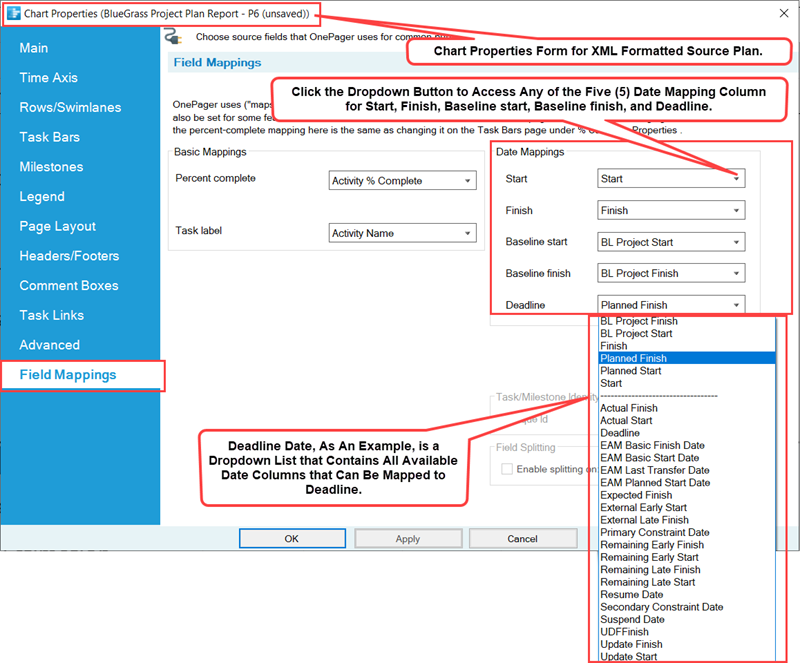
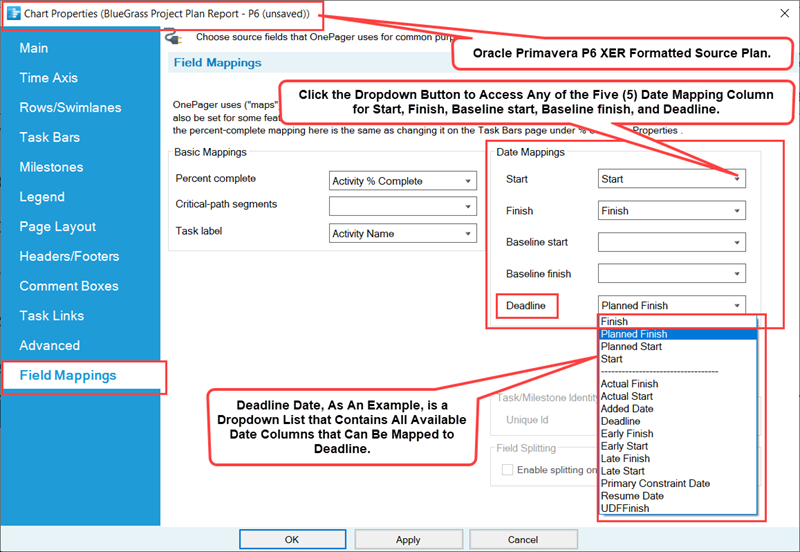
As with the selections in the Basic Mappings control group, selecting a different Oracle Primavera P6 column from the dropdown list tells OnePager to go back to the Oracle Primavera P6 source plan, retrieve the data for that column, and use that data for the designated the OnePager purpose in the chart. This re-acquisition of Oracle Primavera P6 source plan data is done when you click Apply on the Chart Properties form which keeps the Chart Properties form visible or when you click OK which closes the Chart Properties form. The current chart is updated accordingly in the Chart Editor.
The two illustrations above differ with respect to the Baseline start and Baseline finish controls. Oracle Primavera P6 XER Formatted source plans do not contain specific exported baseline columns while Oracle Primavera P6 XML Formatted source plans do have specific exported baseline columns with user baseline date data. Given this, the Baseline start and Baseline finish windows in the Oracle Primavera P6 XER Formatted source plan version of the Chart Properties form's Field Mappings tab is blank to signify this difference although the dropdown list is pre-populated with some date columns as shown here:
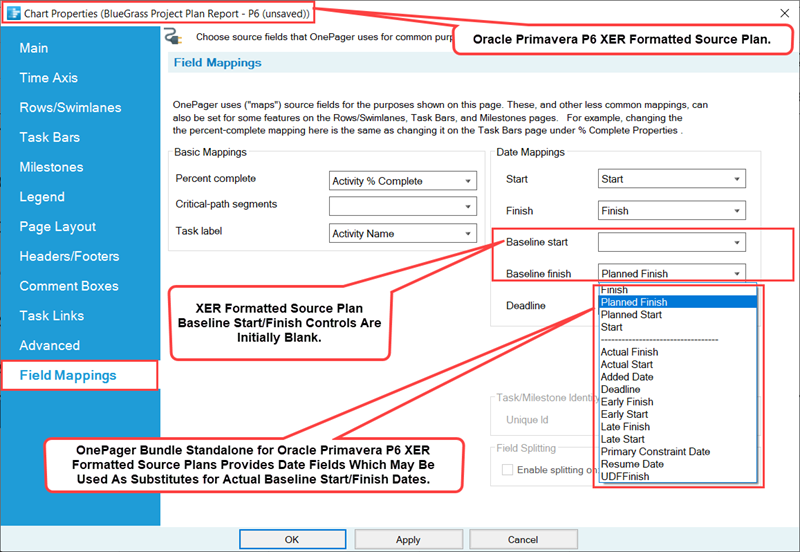
Task/Milestone Identity Mapping
Task/Milestone Identity Mapping for OnePager
In the Chart Properties form, this control group is informational. The control group is disabled in the Chart Properties form but the Unique Id window shows the setting previously or currently set in the Template Properties form’s Field Mappings tab. As such, the window is for information purposes only and cannot be changed.
The Task/Milestone Identity Mapping control group is shown below for the XML Formatted source plan as the XER Formatted source plan's Task/Milestone Identity Mapping sub-control group is the same format and content:
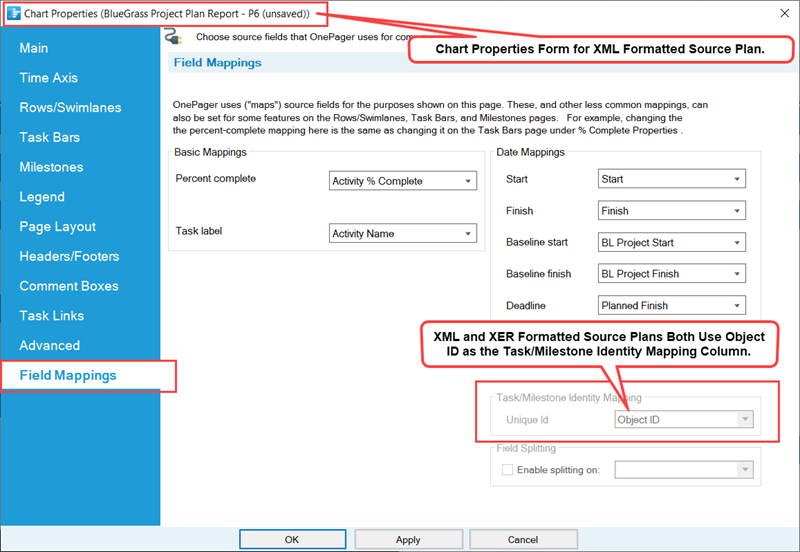
The Unique Id column shows the Oracle Primavera P6 column that OnePager used when it first created the chart. This feature is provided to assist advanced OnePager users update charts that were created from source plans where portions of one Oracle Primavera P6 source plan were copied into another. When OnePager updates a chart, it needs to identify each activity and milestone that is being imported and find out if it already exists in chart. This is how OnePager preserves the formatting of the task bars/milestone symbols and places them in the same row/swimlane where they resided before the update.
When the imported data are a XML or XER Formatted source plans, OnePager uses the Oracle Primavera P6 Object ID column for this purpose. You can control what values of Object ID when you copy data into that source plan. As a result, source plans that had data copied into them can have problems preserving Oracle Primavera P6's formatting and row/swimlane positioning. To solve this problem, OnePager lets you define and use a substitute Oracle Primavera P6 column as an alternative Unique ID for uniquely identifying activities. You are then responsible for guaranteeing that these column values are preserved when data are copied from one source plan to another. You are also responsible for making sure that there are no duplicate values in the column designated for his alternative Task ID usage.
The alternate to Object ID can be set in one of two places:
- 1) In the Template Properties form's Field Mappings tab and
- 2) In the OnePager Choices form's second page by clicking the Edit current template... button.
We strongly recommend that you set the alternate Object ID in the Template Properties form rather than with the OnePager Choices form because this ensures that all charts use a consistent alternative Object ID column.
Reset Unique Ids On Update
The Reset unique ids on update checkbox is disabled in the Advanced tab of the Chart Properties form and cannot be enabled. The disabled checkbox is provided in the form for consistency so that you see that it is there. This feature can be enabled as a last resort under the situation where you are attempting to merge Oracle Primavera P6 source plans from different physical source plans into a single source plan where the Oracle Primavera P6 Unique IDs do not match.
OnePager does not support the combination of XML and XER Formatted source plans when merging different source plans or creating multi-project OnePager charts.
Contact OnePager Support for information on how to use this rarely-used feature by referring to the article at: Getting Support and Contacting OnePager
For additional help, please go to the following link to the OnePager Frequently Asked Questions page: Selecting a Custom Unique ID.
If you encounter difficulties, contact our Support Team at support ticket, by e-mailing us, or by calling +1.303.779.0344.
Field Splitting
As with the control group discussed previously, the Field Splitting control group is disabled but shows the Oracle Primavera P6 column currently set in the Template Properties form as the column participating in field splitting. As such, the window is for information purposes only and cannot be changed. For most OnePager distributed Template Properties forms for Oracle Primavera P6, this window is blank.
The Field Splitting control group is shown below for the XML Formatted source plan as the XER Formatted source plan's Field Splitting sub-control group is the same format and content:
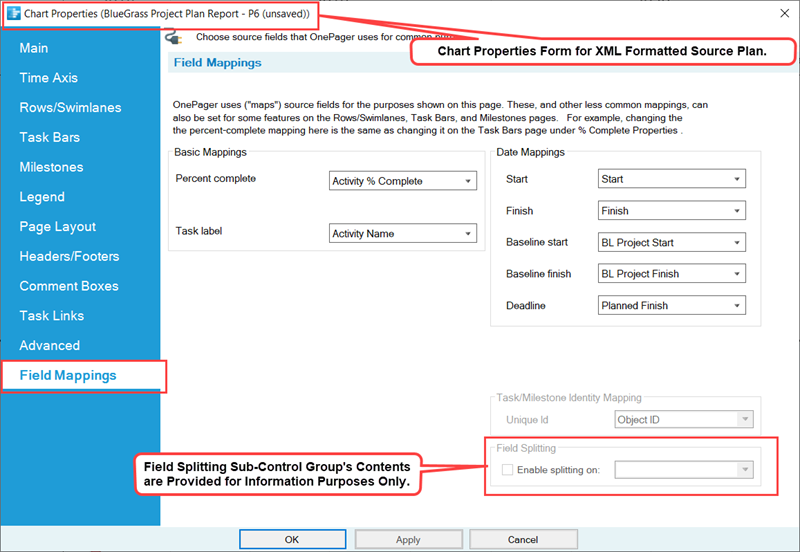
For more information on Splitting and parsing columns, please see the articles at: Splitting and Parsing Columns for Primavera P6 Source Plans
Related Links
Advanced Tab for OnePager -Reset Unique Ids On Update
Splitting and Parsing Fields-OnePager Pro
Splitting and Parsing Fields-OnePager Express
Splitting and Parsing Columns for Primavera P6 Source Plans in OnePager
Splitting and Parsing Columns for Smartsheet Source Plans in OnePager
Getting Support and Contacting OnePager
(21.18.1-71)